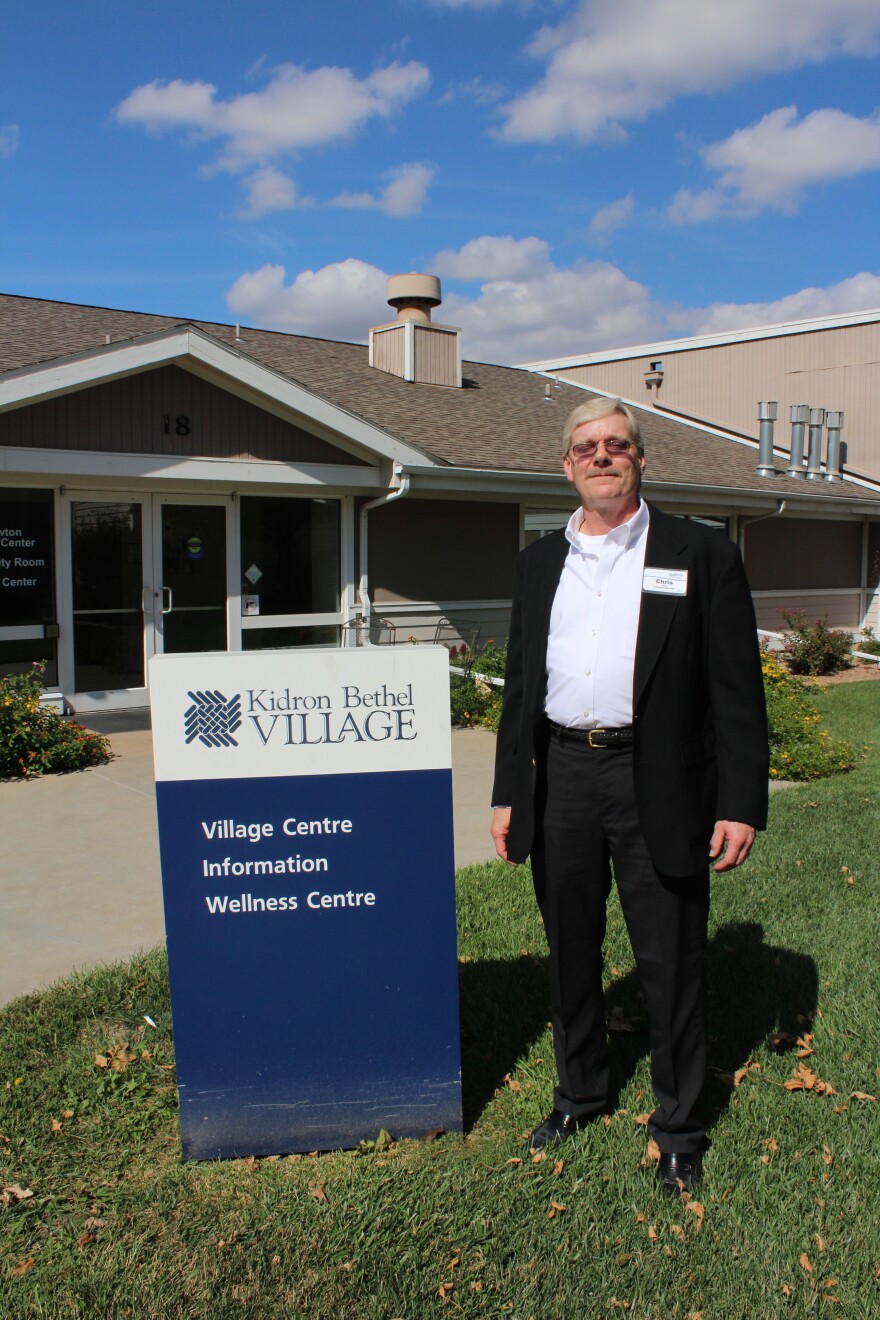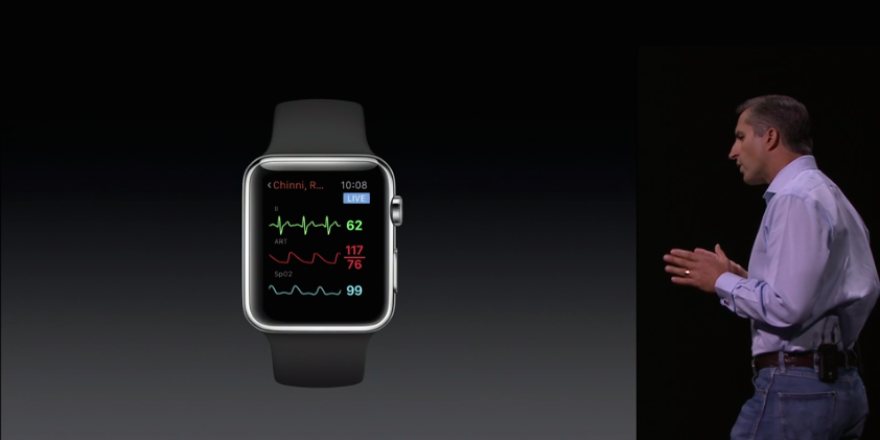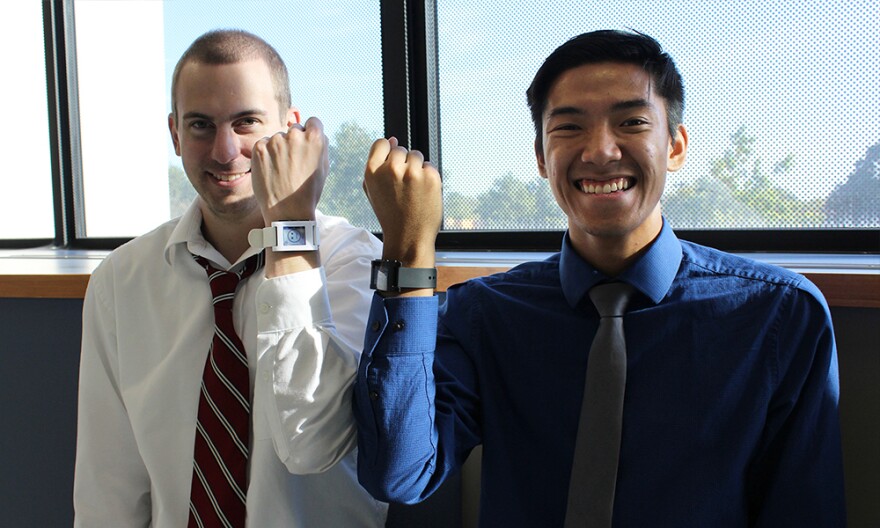Doctors across the country currently face a challenge: How do you track a patient once they’ve left your office? Sometimes what seems like minor pain can turn into an emergency situation, which might have been avoided if it had been caught early. Local physicians who provide care to the elderly say the key is daily monitoring--and because it’s the 21st century, why not use technology? KMUW’s Sean Sandefur reports on how smart watches could be the answer.
Last winter, we met Tony Dezenzio at his apartment complex in Wichita. It was for a story about the federal government’s PACE (Program of All-Inclusive Care for the Elderly) program, which is offered locally through Via Christi HOPE. It provides daily treatment, counseling and socialization for low-income seniors who face numerous health problems, but who are still able to live on their own.
Dezenzio jokes around with his neighbors as they wait for a parade of Via Christi buses to take them to various doctor’s appointments.
Dezenzio relies on this transportation, and couldn’t get the care he needs without it. But for PACE participants who live in more rural areas, transportation is a big concern. Daily, sometimes even weekly check-ups aren’t possible, and doctor’s struggle to monitor their illnesses and pain levels. So, what’s the answer?
A potential solution can be found on the second floor of Wallace Hall at Wichita State University. That's where Brandon Bartlett and Linh Vu have invented a smart watch application they say will help doctors remotely monitor their patients.
The two are in the biomedical engineering field: Bartlett is still finishing up his degree at Wichita State, and Vu has already graduated. Their app is called Mobile Health Link; Via Christi's PACE program asked the two to develop the technology, which is still being tested and isn't yet on the market.
"It will help especially with PACE organizations who have to service populations that may be spread out in large areas," Bartlett says. "Some of them don’t have automobiles and be able to actually travel in. So it becomes important for the PACE organizations to travel out to them. That’s inconvenient for everybody involved--having to take a doctor and somebody else out there.”
The fear is that without frequent checkups, minor issues can lead to much larger ones, and if left untreated, could force patients into assisted living centers.
The way the Mobile Health Link app works, Vu explains, is a patient "will answer a set of questions that determine the status of their health, and those responses are transmitted to the online database, where the physician can view those results.”
The questions are answered by pressing small buttons on a smart watch—in this case, a Pebble. These wearable devices are slim and feature a simple, black-and-white display. They’re on the affordable end of the wearable device spectrum: about $100. In theory, these watches can take the place of vital checkup appointments, which usually require long treks to the doctor’s office.
“The questions are tailored to a person’s specific disease," Vu says, "so a person with chronic obstructive pulmonary disorder—issues with their lungs—can [be asked] questions such as, 'Are you breathing OK? Are you feeling faint? Have you been coughing a lot recently?'”
Vu says most of these questions are asked using a scale of one to 10, or a smiling face versus a frowning face. Once the patient answers them, the data is sent immediately to software installed on the doctor’s computer, tablet or smartphone. The application tracks the responses over days, weeks and months and can alert a doctor if a patient is on a downward trend.
“Say there’s a score of bad, bad, bad in a streak, it will be able to be recognized and then the physician will get a notification letting them know, 'Hey, you should check out this patient because he’s not breathing OK,'" Vu says.
The app also protects against unneeded checkups. If a patient is feeling fine after minor surgery or after starting a new medication, a trip to doctor can be avoided. Now, this sounds good on paper, but does it really work? Vu and Bartlett are testing their application at both Via Christi and Bluestem Communities, a company that owns retirement communities in Harvey County.

Bluestem’s PACE program is still getting off the ground. Director Chris Scott says once they start accepting PACE participants, remote health monitoring will be vital. They’re going to offer the program throughout central Kansas, with a headquarters in McPherson.
“It basically covers 15,125 square miles, so our ability to help individuals becomes more challenging because of the geographic distances," he says.
Scott says there’s no doubt that remote monitoring is the future of health care, but for these devices to be successful, they have to be simple and easy to understand. Otherwise, they’re just another barrier to staying healthy. He says he likes that many of these applications utilize 'yes' or 'no' answers, and pain levels are rated by numbers or smiling faces.
“And certainly for the age group today, many of them do not have the experience with technology," Scott says. "By being able to make this something that’s very simplistic and interactive, especially if a potential participant is developing some level of dementia, this is a very user-friendly fashion to engage them.”
The market for devices and applications like Mobile Health Link is big right now. When the new operating system for Apple Watch was launched last month, health care took center stage. Dr. Cameron Powell, who developed an application called Airstrip, spoke before a large crowd in San Francisco at the Sept. 9 unveiling.

“Now, Airstrip has been used already to monitor over 3.5 million pregnant women in the hospital," he said. "But with our new product, Sense4Baby, we can now monitor these women at home, leveraging Apple Watch.”
Airstrip uses heart rate and blood pressure sensors that are attached to an Apple Watch to monitor both the mother and her baby. Doctors can send messages, asking the mother to perform tests and then share this information with other care providers.
Vu and Bartlett eventually want to add functions like this to Mobile Health Link. Vu says wearable devices are still in the dark ages, but the technology is advancing quickly.
“They have this capability to incorporate 'smart straps,' which are basically a wearable sensor band. So that way, we can take temperature, we can take blood pressure, we can take physiological levels as well," he says.
With patient's personal data flying from smart watch to smartphone to computer, security can be a concern. Vu says they first want to test the main function of their application, which still has a few kinks, and then tackle privacy.
After all their testing is complete, he says they want to turn their application into a business and have a small, but impactful corner on the market of wearable technology.
--
Follow Sean Sandefur on Twitter @SeanSandefur.
To contact KMUW News or to send in a news tip, reach us at news@kmuw.org.


